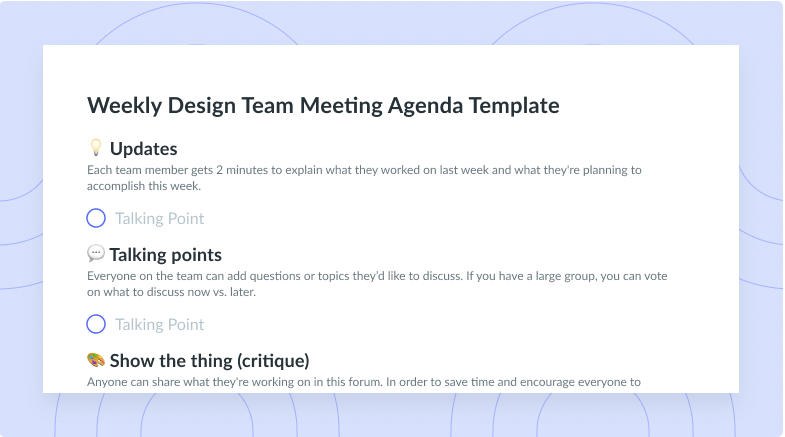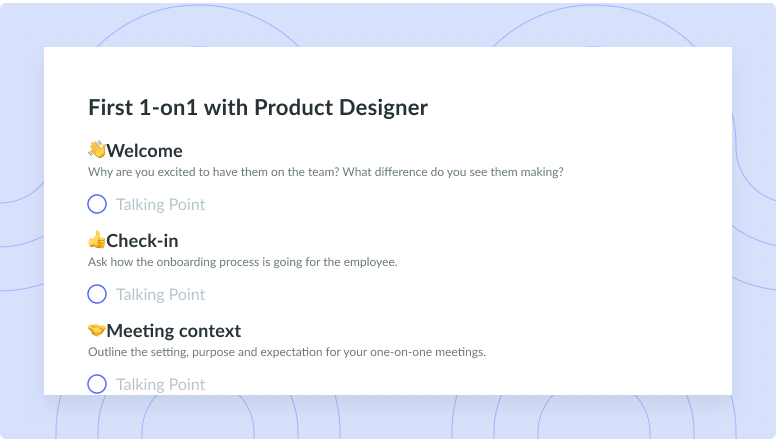
First Meeting with New Team Agenda Template
Get this templateUse this First Meeting with New Team Agenda Template to get your team off to a great start as their new manager: Introduce yourself, get to know the team, set expectations, feedback.




Becoming a team’s new manager
Whether you were hired to manage an existing team, or you’ve been promoted to manage people who were once your colleagues, or you’ve hired your own dream team — it’s time to prepare for your first team meeting!
You’ve worked hard to get here, but your hard work has also just begun — and the first meeting you have with your team is where it all starts.
What is the goal of this meeting?
It’s okay to be nervous. It’s normal to feel overwhelmed by all the ideas you might want to share with your new team — but remember, you don’t need to hit every detail in this first team meeting. The first meeting between you and your new team should have 3 goals:
1. Making a solid first impression on your team.
2. Establishing trust, respect, and rapport.
3. Setting the tone and expectations for you and your team to succeed together long-term.
Tips
To do this, keep this first meeting short and casual. Resist the urge to jump head-first into shop-talk and take the opportunity to get to know your team and really listen to them. Doing this early on will help you understand your team better and will pay dividends in the long run. You can follow up with your team for more detailed discussions in subsequent one-on-one meetings.
To help you get off to a great start, we’ve researched first team meeting ideas from the world’s top management experts and put together the following agenda for better first staff meetings.
What’s inside this first team meeting template:
1 Get to know the team
You’re new in this role, so taking the time to go through some meeting icebreakers will help you in a few ways:
1. It’s an opportunity for you and the team to get to know each other.
2. Right away, they’ll help boost everyone’s energy level.
3. A casual starting point will help people feel more comfortable speaking up and contributing their thoughts, moving forward.
This piece of the first team meeting agenda can also help you to foster a sense of camaraderie — but be mindful of the questions you ask! In a June 2019 article in the Hubspot blog, Caroline Forsey outlines the importance of this:
“The best ice breakers have the power to strengthen coworker bonds, stimulate better brainstorming sessions, and create an atmosphere of inclusivity. But it’s easier said than done, and the wrong ice breaker questions can lead to awkwardness or even increased tension.”
In short, make sure the icebreakers are open-ended and give your team members an opportunity to share something real about themselves.
In addition to getting to know your team on a personal level, these pieces of information can help you tailor your management style to get the best out of your team from the get-go and in the long-run. Active listening and/or notetaking are helpful here.
Team meetings are better in Fellow
Fellow is the meeting management app that companies like Shopify, Uber, and KeepTruckin use to run effective team meetings.

2 Introduce yourself
After everyone has had a chance to speak during icebreakers, you should take some time to give a brief overview of your background. Sure — you can talk about your accomplishments and expertise — but this isn’t an audition; it’s an opportunity to build trust.
Resist the impulse to monologue about yourself; you don’t want to come across as self-absorbed. Instead, try to outline how you hope to support the team.
Share a short, personal story that exemplifies your work style or leadership philosophy. Show your team what motivates you and impresses you by telling them what you’re passionate about outside of work. The sooner your team gets to know you, the sooner they’ll feel comfortable with you.
3 Ask the team for feedback
If you’re the new manager of an existing team, this is your opportunity to find out about how they’ve worked in the past, and get feedback so you can start to make some improvements. If this is a new team, use this time to find out people’s work styles and their personal recipes for success. Either way, use the information you learn in this part of the first team meeting agenda as fodder for some early, small wins to earn your team’s trust.
The Manager’s Resource Handbook provides the following insight into what types of questions you should ask your team to get the right information:
“Ask questions that give you an understanding of the team’s current state. That is, the current opportunities, challenges, issues and possibilities. The questions you ask should help you evaluate things like morale, workload, skills and barriers.”
Mary Shapiro, who teaches organizational behaviour at Simmons College and is the author of the HBR Guide to Leading Teams shares a useful tactic to get everyone aligned on processes:
“One particularly effective exercise is to have people share their best and worst team experiences. Discussing those good and bad dynamics will help everyone get on the same page about what behaviour they want to encourage—and avoid—going forward.”
You can use this exercise and also come prepared with some questions to get the discussion started:
- How do people typically communicate?
- What’s your favourite thing about working here?
- What elements could be improved?
- What are you most excited about moving forward?
- How do you prefer to give and receive feedback?
Starting the conversation about feedback in your first staff meeting shows your team that you value clear, honest communication and will help set the tone for ongoing openness.
4 Set expectations
This is where you can outline a basic vision for your team and share some of the goals you have in mind. Keep it general and thematic to encourage the team to contribute their ideas as well. Again — your focus initially should be learning, so don’t try to present anything that attempts to overhaul the team’s existing structure, here.
Michael Watkins, the cofounder of Genesis Advisers and author of the updated The First 90 Days says:
“It’s actually rare that someone gets to come in and redefine the goals for the group in a profound way.”
Use this time to establish your expectations and ground rules by explaining how you’d like the team to work.
In an article in the Harvard Business Review, Carolyn O’Hara outlines how you can make your expectations clear to your team:
“Explain what’s behind each of your decisions, what your priorities are, and how you will evaluate the team’s performance, individually and collectively. Walk them through what metrics you might use to gauge progress so that they understand how they’ll be evaluated and what’s expected of them.”
In addition to outlining your own expectations, give your team an opportunity to communicate their needs. During this part of the first team meeting agenda, you and your team can start to answer some important questions together:
- What are this team’s values?
- What does success look like?
- How will we as a team track our progress?
- How will the team communicate decisions and updates?
- How can we all support each other to do our best work?
5 Open up the floor for questions
Be sure to leave time at the end of the meeting to open up the floor to your team. This will ensure that everyone leaves the meeting with a clear understanding of everything, and it reinforces your openness.
Finally, be sure to clarify next steps and schedule one-on-ones with each team member to go into more detail about their individual roles, and answer any questions in more detail. This will demonstrate that you are a proactive leader.
The more you communicate with your team early on, the faster your team will get to know you, and the better you’ll all be able to work together moving forward.
Ultimately, the more you can arm yourself with information beforehand, the less nervous you will feel going into your first team meeting. Plus, if you use the free first team meeting template in Fellow, you’ll feel prepared for any curveballs that come your way!
















